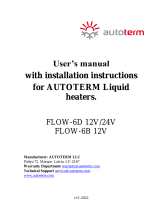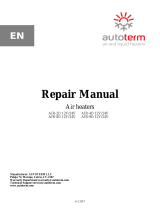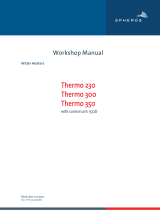AUTOTERM Air 4B
5
4. Description of Heater Structure and Operation
The heater operates independently from the vehicle engine.
The fuel and electric power supply is provided by the vehicle. See Figure 4.1 for
the heater wiring diagram.
The heater is a self-contained heating device comprising the following:
- Heating device (See Figure 4.2 for basic components thereof);
- Fuel supply pump providing fuel for the combustion chamber;
- Ignition and indicator device (control panel);
- Wiring harness connecting heater fittings to the vehicle battery.
The heater’s operating principle is based on heating air driven through the
heater’s heat exchange system.
The heat sources are fuel combustion gases from the combustion chamber. The
resulting heat warms the walls of the heat exchanger, which is air-blown from the outside.
Air passes through the ribbing of the heat exchanger and enters the passenger compartment
or other compartments of the vehicle.
Upon ignition, control unit of heater checks the heater to ascertain whether
fittings such as the flame indicator (the indicator of a flame combines in itself functions of
the sensor of temperature of the heat exchanger and the overheat sensor), air pump motor,
plugs, fuel supply pump and the electric circuits thereof are working properly.
If no problem is detected, the ignition process starts.
In accordance with the preset sequence, the combustion chamber is fore-purged
and the heating plug warms up to the required temperature. Air and fuel starts to enter the
combustion chamber under the same procedure, whereupon the ignition process is initiated.
Once stable combustion is achieved, the heating plug switches off. Flame control is
provided by the flame indicator. All processes involved in heater operation are monitored
by the control unit.
The control unit controls heat exchanger temperature and halts the combustion
process as soon as the temperature exceeds the specified limit. The heater may be switched
off at any time.
Pressing the heater deactivation command stops the fuel entering and the
combustion chamber is purged with air.
During automated operation control of the heater in emergency situations, bear in
mind the following:
1) In the event of ignition failure, the process will be repeated. The heater will switch
off following two consecutive ignition failures;
2) If combustion stops during heater operation, the heater switches off.
3) If the heat exchanger is overheated (maybe as a result of closure of the heater
inlet/outlet vents), the heater will switch off automatically;
4) If voltage drops below 10V or exceeds 16V the heater will switch off.
5) Malfunctions occurring during heater operation are coded and automatically
displayed on the control panel by blinking of the red LED (with pause). For malfunction
reset, press any key.






















